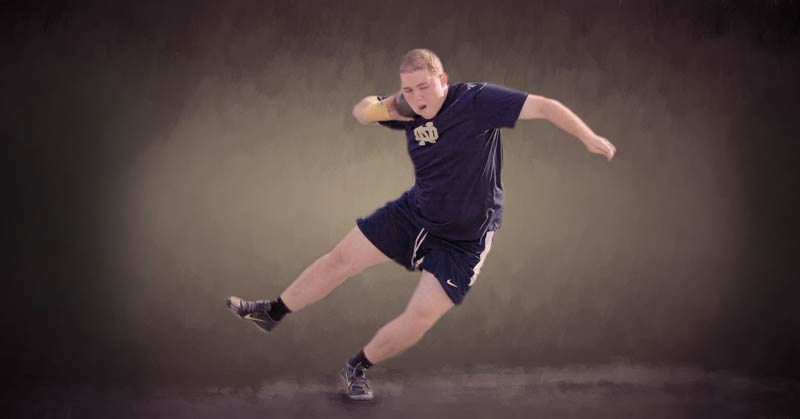
By Nick Garcia
In the next few weeks, it is my goal to do a multiple part article on the setup and application of Dr. Bondarchuk’s system as it was taught to me and how I understand it.
First off it is extremely important to me that I give credit to the people who have guided me in the right direction with this system. Derek Evely and Martin Bingisser. Martin runs a site called HMMR Media which has a plethora of information on this system and various other topics from a group of experienced coaches. Martin and I also do a weekly podcast on numerous training ideas, theories, and often include a guest.
It Starts With Exercises
To get started with Dr. B’s system, you must first understand how each of the exercises is classified. The whole system is built upon exercises, and, therefore, it is crucial to know what category each one belongs. There are four exercise classifications: CE = Competitive Exercise, SDE = Specific Development Exercise, SPE = Specific Preparatory Exercise, and GPE = General Preparatory Exercise.
CE or Competitive exercise is doing the competitive movement whether it is with the competition implement or various other light and heavy implements.
SDE or Specific Development Exercise is a movement that closely resembles the competitive movement but is done with something other than the traditional implements. For example, you could do a stand throw with a 50lb sandbag or med ball.
SPE or Specific Preparatory Exercises are movements that use the same prime muscles as the competitive exercises but does not necessarily mimic the motion. For a thrower, this might be an Olympic Lift or lower body movement such as a step up or squat.
GPE or General Preparatory Exercises are exercises that are completely different than the CE’s and can even use different energy systems if performed in a circuit fashion in which I like to do it. I structure my GPE’s in this manner to keep balance throughout the body. 1 Transverse plane core movement or Twist, 1 Frontal plane core movement, one back exercise, and one sagittal plane core movement. Within these core movements, I try to include movements that may aid in other areas. For example, when doing my frontal plane movement one exercise I will perform is the KB Windmill. Not only does that work the core but it also works shoulder stability and flexibility. And by doing all the exercises together there is also a cardio element to the circuit. Being creative here is a key.
Putting Together a Training Cycle
Exercises are the individual elements of the system, but they have to be put together into a training cycle. Each training cycle throughout the year falls into 1 of 3 categories depending on what role it needs to play.
The first cycle to discuss is the Developmental Cycle. This is where most if not all the development takes place. Obviously that is why it has the name it has. The objective of this cycle is to hit what is called PEAK Form. Once PEAK form is reached you have a number of sessions before you begin to decline in performance. PEAK form is always dependent upon the athlete. For example, my PEAK form is between 16-22 sessions. After 22 sessions my performance declines. Like I said all athletes are different. My younger athletes tend to hit PEAK form between 23-28 sessions. To pinpoint this, data will have to be taken each session. How to do this and determine PEAK form will be discussed at a later time. The Development Cycle includes each of the following discussed above: CE, 1 SDE, 2 SPE’s, and 4 GPE’s. Following the developmental cycle, you have two choices. Move to rest/cleanse cycle or move to Maintenance. Let’s discuss moving to the Maintenance Cycle first.
PEAK form is always dependent upon the athlete. - Nick Garcia on the Bondarchuk System Share on XAfter the developmental cycle would move to the Maintenance Cycle when there is not enough time to fit in a rest/cleanse cycle and another Developmental Cycle. The goal of this cycle is to maintain a high level of performance for a long period of time. For example, when the end of the season comes near in the college setting you have a number of meets you have to perform your best. That normally starts with the conference meet followed by regionals, NCAA finals, and USA’s. It is a real challenge to be at your best for all of these meets, so the Maintenance Cycle is meant to hold a high level of performance to get you through each meet at or close to PEAK form. Setting up the Maintenance cycle is the same as setting up the Developmental Cycle. The exercises are just switched every 14 days no matter what. You can run many Maintenance Cycles back to back to back without a problem.
Finally, let’s have a look at the Cleanse/Rest Cycle. The objective of the Cleanse/Rest Cycle is to help you recover from the previous Developmental or Maintenance cycle and to Cleanse your body of all the previous exercises that your body had adapted too. The length of this also depends on the athlete. Too few sessions can ruin the reaction in the next Developmental Cycle. I always like to do 20 sessions using this method to make sure my body is completely cleansed of the previous cycle. The basic set up of this cycle is to throw 4-5 reps with a lighter then normal implement and perform 5 Bodyweight, Kettle Bell, or Med Ball Exercises after the throws. I sequence these exercise like so: an explosive, lower body, back, twist, and abdominal. An example would be: KB throw for height x6, BW Squat x10, Plate Good Morning x6, Plate Overhead Twist x10e, V-Ups x10. You would repeat the sequence of 4-5 throws and five exercises four times total for a total of 16-20 throws and four circuits. After 20 sessions, we would begin a new Developmental Cycle.
Up Next
Next article will focus on exercise selection for developmental and maintenance cycles and how to apply and use the data you collect each training session.
Martin Bingisser and I have produced 90 minutes of video to introduce coaches to the basics of transfer of training, special strength, and periodization. This online video course is available here on the HMMR Media website.
Please share so others may benefit.
[mashshare]



In fact, this “system” is just a copy of Matveev and especially Verkhoshznsky’s work.